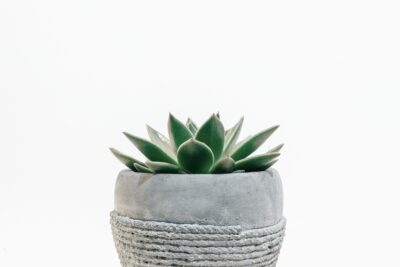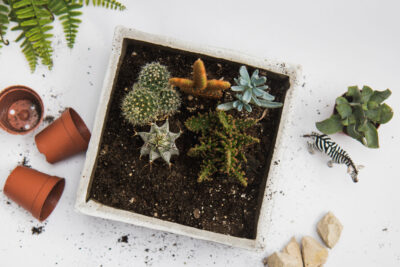
Will Succulents Survive Freezing Temperatures If Left Outdoors?

Succulents are a popular choice for indoor and outdoor gardens due to their unique shapes, low maintenance requirements, and ability to thrive in dry conditions. However, one question that often arises is whether succulents can survive freezing temperatures if left outdoors. This is an important consideration for gardeners living in regions with cold winters, as it can determine whether succulents need to be brought indoors or protected during the colder months.
We will explore the topic of succulents and freezing temperatures. We will discuss the natural habitat of succulents and how they have adapted to survive in extreme conditions. Additionally, we will delve into the factors that can affect succulents' ability to withstand freezing temperatures, such as species variation, acclimation, and protective measures. By the end of this article, you will have a better understanding of how succulents can fare in freezing temperatures and what steps you can take to ensure their survival in your garden.
- Yes, succulents can survive freezing temperatures if properly protected
- Covering succulents with a cloth or blanket can help insulate them from the cold
- Placing succulents in a sheltered location, such as under an overhang or against a wall, can provide additional protection
- Mulching around the base of succulents can help regulate soil temperature and protect their roots
- Bringing potted succulents indoors during freezing temperatures is another option to ensure their survival
- Succulents that are more cold-tolerant, such as certain varieties of Sedum or Sempervivum, have a better chance of surviving freezing temperatures
- Avoid overwatering succulents during winter months, as excess moisture can lead to frost damage
- Regularly monitoring succulents for signs of frost damage, such as discolored or mushy leaves, can help prevent further harm
- Frequently Asked Questions
Yes, succulents can survive freezing temperatures if properly protected
When it comes to succulents, their ability to survive freezing temperatures largely depends on the specific species and their natural habitat. While most succulents are known for their ability to thrive in arid and dry climates, some can actually withstand freezing temperatures if given the right care and protection.
Here are some key factors to consider when determining whether your succulents will survive freezing temperatures:
1. Cold hardiness
Not all succulents are created equal when it comes to cold tolerance. Some varieties, such as Sempervivum (also known as hens and chicks) and Sedum, are naturally more cold-hardy and can withstand freezing temperatures with minimal damage. On the other hand, tender succulents like Echeveria and Aloe vera are more sensitive to cold and may not survive prolonged exposure to freezing temperatures.
2. Acclimation
Succulents that are exposed to gradually decreasing temperatures over time have a better chance of surviving freezing conditions. This process is known as acclimation. By gradually exposing your succulents to cooler temperatures, they can adapt and develop a higher tolerance for cold. However, sudden drops in temperature can shock the plants and make them more susceptible to damage.
3. Protective measures
To increase the chances of your succulents surviving freezing temperatures, it's important to provide them with adequate protection. Here are some measures you can take:
 Ideal Growing Conditions for Succulent Plants: Full Sun or Shade?
Ideal Growing Conditions for Succulent Plants: Full Sun or Shade?- Move indoors: If possible, bring your potted succulents indoors when freezing temperatures are expected. This will provide them with a controlled environment and protect them from extreme cold.
- Cover or insulate: For succulents planted directly in the ground, covering them with a frost cloth or insulating material can help shield them from freezing temperatures. Avoid using plastic materials directly on the plants, as this can trap moisture and cause damage.
- Provide shelter: Placing your outdoor succulents in a sheltered spot, such as against a wall or under an overhang, can provide some protection from harsh winds and frost.
- Water sparingly: Overwatering succulents during cold weather can increase the risk of damage. It's important to reduce watering frequency and only water when the soil is completely dry.
4. Post-freeze care
After a freeze, it's important to assess the extent of the damage and take appropriate action. Remove any dead or damaged leaves to prevent rot and disease. If the stem of your succulent appears mushy or blackened, it may be a sign of frost damage. In such cases, it's best to trim off the damaged parts and allow the plant to recover.
While succulents can survive freezing temperatures if properly protected, it's important to remember that extreme cold can still pose a risk to their overall health. If you live in an area with harsh winters, it may be advisable to grow cold-hardy succulents or keep them indoors during the colder months to ensure their survival.
Covering succulents with a cloth or blanket can help insulate them from the cold
When a winter frost is approaching, many succulent owners start to worry about the fate of their beloved plants. Succulents are known for their ability to thrive in dry and arid conditions, but how well do they fare in freezing temperatures?
The answer to this question depends on a few factors, such as the specific type of succulent, the duration and intensity of the cold weather, and the overall health of the plant. While some succulents are more cold-hardy than others, most of them are not equipped to withstand prolonged freezing temperatures.
If you live in an area with frequent frost or snow, it is advisable to take precautionary measures to protect your succulents. One effective method is to cover them with a cloth or blanket. This simple act can provide insulation and help prevent frost damage.
Why does covering succulents work?
When you cover succulents with a cloth or blanket, you create a barrier that traps heat and prevents the cold air from directly affecting the plants. This insulation helps to keep the temperature around the succulents more stable, reducing the risk of freezing.
 Succulents and Frost: Unveiling Their Cold Hardy Traits
Succulents and Frost: Unveiling Their Cold Hardy TraitsIt is essential to choose a breathable material for covering your succulents. Avoid using plastic or non-porous materials as they can trap moisture and promote rot. Opt for a breathable fabric that allows air circulation while still providing protection.
Properly covering your succulents
Here are some tips to ensure you cover your succulents effectively:
- Wait until evening: Covering your succulents in the evening is ideal as the temperature drops. This way, you give them a head start in warming up before the cold night.
- Use stakes or supports: If you expect strong winds, use stakes or supports to hold the cloth or blanket in place. This will prevent them from blowing away and exposing your succulents.
- Leave room for air circulation: Make sure the cloth or blanket is not tightly wrapped around the succulents. Leave some space for air circulation to prevent moisture buildup.
- Remove the cover during the day: When the temperatures rise during the day, remove the cover to allow the succulents to receive sunlight and fresh air.
Note: It is crucial to monitor the weather conditions and remove the cover if the temperature rises significantly or if the risk of frost has passed. Leaving the cover on for an extended period can lead to trapped moisture and potential damage to the succulents.
While succulents are generally not well-suited for freezing temperatures, you can increase their chances of survival by taking simple precautions. Covering them with a cloth or blanket offers insulation and protection from frost damage. Remember to choose a breathable material and follow the proper covering techniques. By doing so, your succulents can brave the cold and emerge unscathed when spring arrives.
Placing succulents in a sheltered location, such as under an overhang or against a wall, can provide additional protection
When it comes to succulents, their ability to survive freezing temperatures largely depends on the specific type of succulent and the severity of the cold. While some succulents are more cold-hardy than others, it is generally recommended to take precautions to protect them during freezing weather.
If you live in an area where freezing temperatures are common, it is important to consider the following tips to ensure the survival of your outdoor succulents:
 The Limit of Succulent Plant Growth: How Large Can They Grow?
The Limit of Succulent Plant Growth: How Large Can They Grow?- Choose cold-hardy succulents: Some succulents, such as Sedum, Sempervivum, and Agave, are more tolerant of cold temperatures. Prioritize planting these varieties in your outdoor garden to increase their chances of surviving freezing weather.
- Provide proper drainage: Succulents are prone to root rot if they are exposed to excess moisture. Make sure your succulents are planted in well-draining soil and that their containers have drainage holes to prevent water from accumulating.
- Protect from frost: Frost can be detrimental to succulents, causing their cells to rupture and leading to irreversible damage. When freezing temperatures are expected, cover your succulents with frost cloth or blankets overnight to shield them from freezing winds and frost formation.
- Avoid overwatering: During winter, succulents enter a period of dormancy and require less water. Overwatering can lead to root rot and make them more susceptible to cold damage. Reduce watering frequency and only water when the soil is completely dry.
- Utilize natural barriers: Placing succulents in a sheltered location, such as under an overhang or against a wall, can provide additional protection from freezing temperatures. These natural barriers can help block cold winds and create a microclimate that is slightly warmer.
By following these guidelines, you can significantly increase the chances of your succulents surviving freezing temperatures when left outdoors. Remember to monitor the weather forecast and take appropriate measures to protect your beloved succulents during the colder months.
Mulching around the base of succulents can help regulate soil temperature and protect their roots
When it comes to succulents, their ability to thrive in various conditions is one of their most appealing traits. However, one question that often arises is whether succulents can survive freezing temperatures if left outdoors. While succulents are known for their resilience, extreme cold can pose a challenge to their survival.
To protect your outdoor succulents from freezing temperatures, one effective method is mulching. Mulching involves adding a layer of organic material, such as straw or wood chips, around the base of the succulents. This layer acts as insulation, helping to regulate the soil temperature and protect the roots from extreme cold.
Mulching not only helps to keep the soil warm but also prevents water from freezing around the roots of the succulents. When water freezes, it expands, which can cause damage to the delicate root system. By insulating the soil with mulch, you can prevent water from freezing and potentially harming your succulents.
Choosing the Right Mulch
When selecting mulch for your succulents, it's important to choose a material that will provide adequate insulation without retaining too much moisture. Succulents are adapted to arid environments and are prone to root rot if their roots are constantly wet.
Some suitable mulch options for succulents include straw, wood chips, or even crushed rocks. These materials allow for proper drainage while still providing insulation. Avoid using materials like peat moss or bark, as they tend to retain more moisture, which can be detrimental to succulents.
Applying Mulch Correctly
Proper application of mulch is essential to ensure its effectiveness in protecting your succulents. Start by removing any weeds or debris from around the base of the succulents. Then, spread a layer of mulch about 2-3 inches thick, making sure to leave some space around the stem to prevent moisture buildup and potential rot.
 Do Succulents Need Sunlight in Winter?
Do Succulents Need Sunlight in Winter?It's important to note that mulch should be applied before the arrival of freezing temperatures. By doing so, you can better prepare your succulents for the cold weather ahead. Additionally, monitor the moisture levels regularly and adjust the mulch layer if needed, as succulents still require some watering even during winter dormancy.
While succulents are generally hardy plants, taking precautions to protect them from freezing temperatures is crucial for their survival. Through proper mulching techniques, you can help regulate soil temperature, prevent water from freezing, and safeguard the roots of your outdoor succulents.
Bringing potted succulents indoors during freezing temperatures is another option to ensure their survival
When the cold winter months approach, many succulent enthusiasts wonder if their beloved plants will be able to withstand the freezing temperatures if left outdoors. While succulents are known for their ability to thrive in arid and desert-like conditions, not all succulents are equipped to survive extreme cold.
If you live in an area where temperatures regularly drop below freezing, it is highly recommended to bring your potted succulents indoors to ensure their survival. While some hardy succulent species can tolerate brief periods of frost, prolonged exposure to freezing temperatures can be detrimental to their health.
Why bring succulents indoors during freezing temperatures?
Succulents are adapted to store water in their leaves and stems, making them excellent at withstanding drought conditions. However, this doesn't mean they are immune to freezing temperatures. When exposed to extreme cold, the water stored in their tissues can freeze, leading to cell damage and ultimately plant death.
By bringing your potted succulents indoors, you provide them with a controlled environment where you can monitor and adjust the temperature to ensure they stay within their preferred range. Most succulents thrive in temperatures between 60°F and 80°F (15°C and 27°C), making them well-suited for indoor living during the winter.
 The Effects of Direct Sunlight on Succulents: What You Need to Know
The Effects of Direct Sunlight on Succulents: What You Need to KnowTips for bringing succulents indoors
When transitioning your succulents from the outdoors to indoors, it's important to follow a few guidelines to help them adjust to their new environment:
- Gradual acclimation: Succulents can experience shock when suddenly exposed to a significant change in temperature and lighting conditions. To minimize stress, gradually move them indoors over a period of a few days, allowing them to adapt to lower light levels.
- Provide adequate light: Succulents thrive in bright, indirect light. Place them near a south-facing window or provide artificial grow lights to ensure they receive sufficient light during the winter months.
- Adjust watering: Indoor environments tend to have lower humidity levels than outdoors. As a result, succulents may require less frequent watering. Monitor the moisture levels in the soil and water only when it is dry several inches below the surface.
- Maintain proper ventilation: While succulents prefer dry conditions, they still need good air circulation to prevent the buildup of moisture that can lead to fungal diseases. Ensure that the indoor space where you keep your succulents is well-ventilated.
By following these tips, you can provide your succulents with a cozy and protective environment during the freezing temperatures, increasing their chances of survival and thriving until spring arrives.
Succulents that are more cold-tolerant, such as certain varieties of Sedum or Sempervivum, have a better chance of surviving freezing temperatures
When it comes to succulents, not all species are created equal in terms of their ability to withstand freezing temperatures. Some succulents, such as certain varieties of Sedum or Sempervivum, have developed adaptations that make them more cold-tolerant and therefore have a better chance of surviving when left outdoors during freezing temperatures.
Sedum Varieties
Sedum, also known as stonecrop, is a popular succulent genus that includes many species with varying cold tolerance levels. Some Sedum varieties, such as Sedum spurium (Dragon's Blood) or Sedum rupestre (Angelina), are known for their ability to withstand freezing temperatures and can survive even in USDA hardiness zones as low as 3 or 4.
Dragon's Blood: This Sedum variety features deep red leaves and can tolerate temperatures as low as -30°F (-34°C). It is a hardy succulent that can survive even in harsh winter conditions.
Angelina: With its vibrant yellow-green foliage, Angelina is another cold-tolerant Sedum that can withstand temperatures as low as -20°F (-29°C). This hardy succulent forms a low mat and is a great choice for rock gardens or ground cover in colder regions.
Sempervivum Varieties
Sempervivum, commonly known as hens and chicks, is another group of succulents that are known for their cold tolerance. These rosette-shaped succulents can survive freezing temperatures and are often found in alpine or rocky environments.
 Unveiling the Secrets of Succulents' Resilience in the Harsh Desert
Unveiling the Secrets of Succulents' Resilience in the Harsh DesertArachnoideum: This Sempervivum variety, also known as cobweb houseleek, has a unique appearance with its web-like hairs covering the leaves. It can tolerate temperatures as low as -20°F (-29°C) and is an excellent choice for cold-climate gardens.
Tectorum: Tectorum, also called hens and chicks, is a cold-hardy Sempervivum variety that can withstand temperatures as low as -30°F (-34°C). It forms tight rosettes of fleshy leaves and is often used in rock gardens or as ground cover in colder regions.
- Sedum spurium (Dragon's Blood)
- Sedum rupestre (Angelina)
- Sempervivum arachnoideum (Cobweb Houseleek)
- Sempervivum tectorum (Hens and Chicks)
These are just a few examples of cold-tolerant succulents that can brave freezing temperatures when left outdoors. However, it's important to note that while these succulents may survive freezing temperatures, prolonged exposure to extreme cold can still damage or kill them. It's always a good idea to provide some protection, such as mulching or using cold frames, during severe winter weather to increase their chances of survival.
So, if you're considering leaving your succulents outdoors during freezing temperatures, make sure to choose cold-tolerant varieties like the ones mentioned above and take appropriate measures to protect them from extreme cold. With proper care, these resilient succulents can add beauty to your garden even in the harshest winter conditions.
Avoid overwatering succulents during winter months, as excess moisture can lead to frost damage
During the winter months, succulents may be at risk of frost damage if left outdoors. These hardy plants are known for their ability to withstand harsh conditions, but freezing temperatures can still pose a threat to their survival.
One key factor to consider when it comes to the well-being of your succulents during winter is watering. It is crucial to avoid overwatering during this time, as excess moisture can freeze and cause damage to the plant.
When temperatures drop below freezing, the water inside the cells of the succulent can freeze, leading to cell damage and possible death of the plant. To prevent this, it is recommended to reduce watering frequency and only water when the soil is completely dry.
 Managing Sun Stress: How Succulents Cope with Excessive Sun Exposure
Managing Sun Stress: How Succulents Cope with Excessive Sun ExposureAdditionally, it is important to provide proper drainage for your succulents. Ensure that the pots have drainage holes to allow excess water to escape, preventing waterlogged soil. This will help to minimize the risk of freezing and subsequent damage to the plants.
Furthermore, it is advisable to protect your succulents from extreme cold temperatures by providing them with some form of insulation. This can be done by covering the plants with frost cloth, burlap, or even a layer of mulch. These materials will help to retain heat and protect the plants from the freezing temperatures.
Lastly, consider relocating your outdoor succulents to a more sheltered area during the winter months. Placing them under a covered patio or in a greenhouse can provide extra protection from harsh weather conditions.
While succulents are generally hardy plants, it is important to take precautions during freezing temperatures. Avoid overwatering, provide proper drainage, insulate the plants, and consider relocating them to a more sheltered area. By following these steps, you can increase the chances of your succulents surviving the winter months outdoors.
Regularly monitoring succulents for signs of frost damage, such as discolored or mushy leaves, can help prevent further harm
When it comes to succulents, their ability to withstand freezing temperatures largely depends on the specific species and their natural habitat. While some succulents are native to deserts and can tolerate extreme heat, others are adapted to colder climates and can endure freezing temperatures.
However, it's important to note that even cold-hardy succulents have their limits. Freezing temperatures can still pose a risk to these plants, especially if they are not provided with adequate protection.
 Can Succulents Thrive in Outdoor Summer Conditions?
Can Succulents Thrive in Outdoor Summer Conditions?Signs of Frost Damage
Regularly monitoring your succulents for signs of frost damage is crucial in preventing further harm. Some common indicators of frost damage include:
- Discolored leaves: Frost-damaged succulents may develop dark spots or turn brown or black.
- Mushy leaves: Leaves that become soft and mushy to the touch are often a sign of frost damage.
- Wilting or drooping: Succulents exposed to freezing temperatures may exhibit wilting or drooping leaves.
If you notice any of these signs, it's important to take immediate action to protect your succulents and prevent further damage.
Protecting Succulents from Freezing Temperatures
To help your succulents survive freezing temperatures when left outdoors, consider the following measures:
- Provide shelter: Move potted succulents indoors, a greenhouse, or under a covered patio to shield them from freezing temperatures.
- Use protective coverings: If you cannot move your succulents indoors, cover them with frost cloths, blankets, or cardboard boxes to provide insulation.
- Avoid overwatering: Before the onset of freezing temperatures, ensure that your succulents are not overwatered. Excess moisture can increase the chances of frost damage.
- Consider microclimates: Some areas in your garden or yard may offer slightly warmer temperatures. Position your succulents in these microclimates to enhance their chances of survival.
- Monitor weather forecasts: Stay informed about upcoming weather conditions and plan accordingly. If a frost or freeze warning is issued, take immediate steps to protect your succulents.
By implementing these protective measures and being vigilant in monitoring your succulents, you can increase their chances of surviving freezing temperatures outdoors.
Frequently Asked Questions
1. Will succulents survive freezing temperatures if left outdoors?
Most succulents are not frost-resistant and will not survive freezing temperatures if left outdoors. It is best to bring them indoors or provide them with proper protection during cold weather.
2. How often should I water my succulents?
Succulents have low water requirements and should be watered sparingly. It is generally recommended to water them deeply once every 1-2 weeks, allowing the soil to dry out completely between waterings.
3. Can I plant succulents in regular potting soil?
No, regular potting soil is too moisture-retentive for succulents and can lead to root rot. It is best to use a well-draining succulent or cactus mix, or create a DIY mix with sand, perlite, and potting soil.
 Succulent Flowering Times: When Do They Bloom?
Succulent Flowering Times: When Do They Bloom?4. How much sunlight do succulents need?
Succulents thrive in bright light conditions, preferably receiving at least 6 hours of indirect or direct sunlight per day. However, some succulents can tolerate partial shade for a few hours.
If you want to read more articles similar to Will Succulents Survive Freezing Temperatures If Left Outdoors?, you can visit the Growing Conditions category.






You Must Read